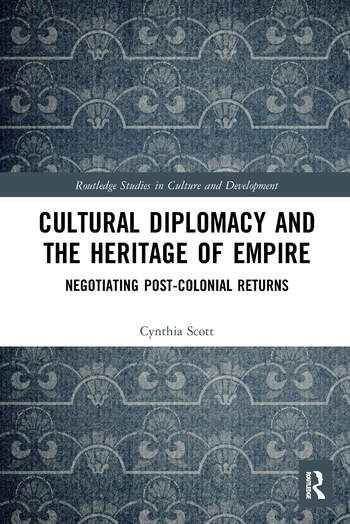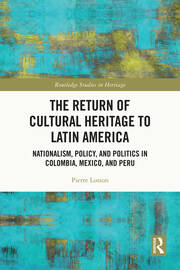Over the past few years, return claims by former colonized countries and Indigenous communities for their stolen cultural heritage and artworks have found a wider echo among general audiences than in previous decades, when this issue remained confined to the small world of museum experts. These claims reveal, in turn, the inherently violent nature of many museums’ collections. Analyzing the relationship between restitution of cultural heritage and violence requires considering both that the act of returning an object from one place to another can represent a form of reparation1Elazar Barkan, “Amending Historical Injustices: The Restitution of Cultural Property—An Overview” in Claiming the Stones, Naming the Bones: Cultural Property and the Negotiation of National and Ethnic Identity, eds. Elazar Barkan and Ronald Bush (Los Angeles: Getty Research Institute, 2002), 16–46. for a nation or a community affected by the violent removal of the traces of their past and that the very process of restitution can obscure—or validate—processes of symbolic (if not physical) violence occurring within these same communities.
Cases for restitution
“Returning objects to their place of origin…represented an attempt to restore a lost (diplomatic, political, cultural) order disrupted by violence.”The movement of cultural heritage objects and artworks has historically been linked to armed conflicts, whether as spoils of war and colonization or as collateral damage to the downfall of the authorities capable of enforcing laws on art and cultural heritage property. In Roman Antiquity, at the end of the Punic Wars, consul Scipio Aemilianus ordered works of art that had been seized by Carthage to be returned to their Sicilian owners.2An episode reported by Cicero in In Verrem 2. The 1815 Treaty of Paris that ended the Napoleonic Wars included an injunction to defeated France to return many of the treasures looted during Napoleon’s campaigns to the other European powers where they originated—but, significantly, not to non-European territories such as Egypt. Closer to us, the ransacking of Baghdad’s Iraq Museum during the US invasion of Iraq in 2003 showed how cultural heritage is a direct victim of armed conflict, even when not targeted as an aim of war.3Manhattan Assistant DA Matthew Bogdanos recounts in Thieves of Baghdad (New York: Macmillan, 2005) how he spent several years recovering thousands of objects and sending them back to Iraq. Returning objects to their place of origin, in all these cases, represented an attempt to restore a lost (diplomatic, political, cultural) order disrupted by violence.
Restitutions also respond to symbolic forms of violence. They seek to redress situations of historical imbalances born from the colonial and imperial ambitions of Western European countries and the expansion of settler states in North America and Oceania. The physical violence used to seize cultural heritage objects or artworks is perpetuated, more insidiously, by the continued retention of these materials far away from the geographical context of their creation.
Several famous examples come to mind.
Since the mid-1980s, multiple voices in Mexico have asked for the return of the last Aztec emperor Montezuma’s featherhead (penacho de Moctezuma), taken to Europe in unclear circumstances in the mid-sixteenth century and currently exhibited in Vienna’s Weltmuseum. Beyond the nature of the object itself,4Most experts now agree that the object was probably not the emperor’s crown but may have been an attribute of religious power worn by high priests. the estrangement of the penacho acts as a cruel reminder of the violence of the Spanish Conquest: if it was a gift by Montezuma to Charles V, as some argue, then the gift was poorly paid in kind as the Aztec Empire was wiped out; if the penacho was stolen, then it is indeed the relic of an era of plunder and genocide rather than the “encounter of two worlds,” as the Conquest has been dubbed over the past few decades. In the twenty-first century, the penacho embodies the unjust dispossession of the cultural heritage of one nation (contemporary mestizo Mexico, which sees itself as a continuator of the Aztec Empire) by European imperial powers (in this case, the Austrian Republic, heir of the Austro-Hungarian Empire). The return of the penacho to Mexico is viewed, by its proponents, as justice done to an aggrieved people.
Examples of the appropriation of non-European cultural heritage objects to be displayed in European museums abound. The Netherlands in Indonesia,5 Routledge, 2020More Info → Italy in Ethiopia, Belgium in the Democratic Republic of Congo6
Routledge, 2020More Info → Italy in Ethiopia, Belgium in the Democratic Republic of Congo6 Ohio University Press, 2015More Info → have also amassed treasures that they have progressively agreed to return since the second half of the twentieth century, as signs of good will to establish new and pacified—if not necessarily more equal—relationships with their former colonies. The extraordinary magnitude of the collections gathered by the British and the French as they expanded their colonial empires in Africa and Asia also creates numerous conflicts.
Ohio University Press, 2015More Info → have also amassed treasures that they have progressively agreed to return since the second half of the twentieth century, as signs of good will to establish new and pacified—if not necessarily more equal—relationships with their former colonies. The extraordinary magnitude of the collections gathered by the British and the French as they expanded their colonial empires in Africa and Asia also creates numerous conflicts.
Changing conceptions of Western museums
In a report commissioned by French President Macron in 2018, scholars Bénédicte Savoy and Felwine Sarr7Felwine Sarr and Bénédicte Savoy, The Restitution of African Cultural Heritage. Toward a New Relational Ethics, trans. Drew S. Burk (Ministère de la Culture and CNRS – ENS Paris Saclay – Université Paris Nanterre, 2018). have shown that a large share of African collections in French public museums were obtained through violence or situations of unequal relations. Consequently, they suggest returning several thousand objects to former French African colonies. In spite of a few symbolic restitutions to Senegal, Benin, and Madagascar, however, the report has so far produced few concrete effects. The institutional inertia of museums has combined with French political elites’ reluctance to engage in a thoughtful process of historical repentance for the crimes committed during colonial rule to prevent a large-scale movement of objects back toward their place of origin.
“They are displayed and conserved according to Western scientific thought by curators who were never meant to be their guardians…”Western encyclopedic museums have for many decades justified holding onto cultural artifacts from around the world by arguing that they possess superior technical and financial capacities—one aspect of the symbolic violence that these institutions of knowledge continue to exert on the rest of the world in the early twenty-first century. The case of the Benin Bronzes is revelatory in this regard: looted from Benin City, in present-day Nigeria, during a so-called “punitive expedition” that barely masked Britain’s imperial ambitions in sub-Saharan Africa, this collection of objects was brought to England by soldiers and colonial administrators. The Bronzes then made their way into the collections of some the most famous museums—as well as smaller, university museums—in Western Europe and North America, where their continued display perpetuates the violence by which they were seized. Indeed, not only are these collections tainted by the circumstances of their removal, but their very display in vitrines (a Western concept), in a very different context from the one they were conceived for (a ruler’s palace), is also the very product of the imperial project of knowledge that accompanied colonization: They are displayed and conserved according to Western scientific thought by curators who were never meant to be their guardians; this system is supported by a highly unequal economic order in which the conservation of objects is, at least in part, funded by colonial systems of exploitation and pillaging.
Consequently, for curators such as Dan Hicks at Oxford’s Pitt Rivers Museum, restitution is the only solution.8 London: Pluto Press, 2020More Info → The recent debate over the fate of the Bronzes has shown how attitudes started diverging within the museum world in the West: while all public German museums, a few smaller museums in the United Kingdom, and the Smithsonian Institution in the United States have agreed to return the Bronzes they hold, their more ethical posture contrasts that of institutions such as the British Museum, which continue to fear that returning a few objects would create a precedent leading to emptying their collections (a fear I have debunked elsewhere9Pierre Losson, “Opening Pandora’s Box: Will the Return of Cultural Heritage Objects to Their Country of Origin Empty Western Museums?” Journal of Arts Management, Law, and Society 51, no. 6 (2021): 379–392.).
London: Pluto Press, 2020More Info → The recent debate over the fate of the Bronzes has shown how attitudes started diverging within the museum world in the West: while all public German museums, a few smaller museums in the United Kingdom, and the Smithsonian Institution in the United States have agreed to return the Bronzes they hold, their more ethical posture contrasts that of institutions such as the British Museum, which continue to fear that returning a few objects would create a precedent leading to emptying their collections (a fear I have debunked elsewhere9Pierre Losson, “Opening Pandora’s Box: Will the Return of Cultural Heritage Objects to Their Country of Origin Empty Western Museums?” Journal of Arts Management, Law, and Society 51, no. 6 (2021): 379–392.).
Museums as sites of imperial/colonial knowledge reproduction
Beyond the cases of objects removed during colonial wars, the current calls for restitution have revealed to the public how, at the turn of the twentieth century, emerging sciences such as anthropology and archaeology were put to the service of imperial projects of knowledge that accompanied military, political, and economic domination. Latin America provides many examples. In the early 1900s, in countries such as Peru and Colombia, there was no national archaeology to speak of—these would only develop in the following decades—and foreign explorers were left relatively free to excavate and export whatever they found. This is how German archaeologist Konrad Theodor Preuss, who traveled to the town of San Agustín in Southern Colombia in 1913–14, shipped to Berlin 35 funerary statues for further studies; there is no evidence he moved these artifacts with any form of authorization from local or national authorities. Blocked by war in Europe, Preuss and the statues arrived in Berlin by 1919. The statues have since remained in the collections of Berlin’s Ethnological Museum, now absorbed in the new Humboldt Forum, in spite of local initiatives in San Agustín to see the statues return to their original location. These demands have so far been ignored by the curator of the museum and the director of the Prussian Heritage Foundation, which oversees the Forum.
In Peru, explorer Hiram Bingham, mandated by Yale University and the National Geographic Society, led the first scientific excavation in 1912–14 at Machu Picchu, which would soon become an icon of Peru. He shipped the products of his search to the United States with the authorization of the Peruvian president of the time. This authorization specified that the materials should be returned after 18 months, but the collection stayed at Yale for almost a century. Starting in the late 1990s, Peruvian authorities mounted a campaign for the collection’s return that lasted for a decade. Yale, while arguing that the statute of limitations had expired,10Western museums have often used legal arguments to justify the retention of cultural heritage. Current return claims oppose a moral or ethical right to strict legalistic understanding of the case. ultimately bowed to intense international and domestic pressure and returned the collection in 2010.
“The museumification of cultural heritage objects imposes a Western-inspired epistemological world order—a subtle yet prevalent continuation of the imperial project of knowledge.”These two cases show how Western institutions of knowledge have practiced a form of symbolic violence by retaining objects that should not have been included in their collections in the first place, a form of domination strengthened by the fact that even restitution does not necessarily mean an object or an artwork will escape the realm of museums. Many objects returned from a country to another—as is the case with the Machu Picchu collection or the Benin Bronzes—continue in the care of experts and never again find a use other than that of museum piece, as if, once out of their original context, cultural objects could never recover any other function (or be left in the care of any other institution).11Exceptions include the repatriation of human remains to Native/Indigenous communities to be reburied. The museumification of cultural heritage objects imposes a Western-inspired epistemological world order—a subtle yet prevalent continuation of the imperial project of knowledge.
If restitutions are constructed as a process to redress a historical injustice done to a community or people from a bygone era and their heirs, or as a sign of respect for a past culture, one outcome could be that objects be returned to their original use. However, when the collection of Paracas funerary textiles held in the Museum of World Culture in Gothenburg, Sweden, was returned to Peru in several steps, from 2014 through 2021, the possibility of reburying them in the coastal desert of Paracas, south of Lima, was never even considered. Paracas textiles, admired for their aesthetic and technical qualities, are now objects of study and cannot be claimed by a living community as an object of ritual or memory.
To whom are objects returning?
The question remains: If restitutions are meant to rectify acts of violence, to whom should an object or an artifact be returned? Restitutions are often made to nation-states, from one country to another. Returning objects back to their “country of origin” has often been disparaged by Western museums, arguing that restitutions were guided by a misplaced nationalism that ignores the specific historical circumstances of removal and the fact that some of the claiming countries did not even exist at the time. Getty Institute Director James Cuno argues that developing countries’ “retentionist” nationalist policies oppose universal museums’ mission to research and conserve the archaeological remains of past civilizations for the benefit of humanity as whole. In his view, restitution claims are only motivated by the nationalist politics of leaders seeking to score points at home. I do not entirely disagree with Cuno: In my book,12 Routledge, 2022More Info → I do show that restitution claims are, indeed, political objects that must be understood within the domestic political context where they appear. Nationalism, however, needs not be considered only as a political ideology ignoring the contributions of science but rather as a principle of cohesiveness for multiethnic, multilinguistic, and (relatively) recent states.
Routledge, 2022More Info → I do show that restitution claims are, indeed, political objects that must be understood within the domestic political context where they appear. Nationalism, however, needs not be considered only as a political ideology ignoring the contributions of science but rather as a principle of cohesiveness for multiethnic, multilinguistic, and (relatively) recent states.
Restitutions, in this context, can represent moments of national unity for populations reconnecting with the physical remains of a past that has been constructed as the collective memory of the community. This was the case in Lima in 2011, when more than 300,000 people visited the collection returned by Yale at an exhibition hastily organized at the National Palace, or more recently in Cotonou, when the 26 objects returned by France were displayed alongside works by contemporary Beninese artists.
“The nation, posing as descendant of glorious empires to justify the return of objects to state authorities, often denies the possibility for specific subnational (Indigenous or not) communities to recover possession of an object.”But nationalism, of course, carries its own history of violence. Indeed, restitutions can sanction or obscure processes of cultural appropriation internal to the claiming country. In Latin America, pre-Columbian objects are returned to a modern (mestizo or mixed-race) nation-state into which the pre-Columbian culture that created them has been assimilated: The nation, posing as descendant of glorious empires to justify the return of objects to state authorities, often denies the possibility for specific subnational (Indigenous or not) communities to recover possession of an object. For example, there is allegedly no Indigenous community in Mexico who would claim higher legitimacy than the Mexican state over the penacho de Moctezuma if it ever were to be returned—three centuries of colonialism and two centuries of the modern republic have erased such possibility. In the twentieth century, the republic conflated Indigeneity (at least, its pre-Columbian version) into Mexicanness—more perversely, though, while only slowly recognizing full citizenship for contemporary Indigenous people and keeping them in social and economic marginalization.
Nationalism, to be sure, is not the prerogative of claiming (developing) nations: The Western countries that hold the claimed objects are hardly exempt from the nationalist logic. Their imperial and colonial projects were implemented in the context of intense nationalist rivalries among Western powers and served to demonstrate military, technological, and industrial superiority. Museums’ pretense to universality, in this regard, was a part of—rather than an antidote to—their nationalist ambitions.13 Cambridge: Cambridge University Press, 2008More Info →
Cambridge: Cambridge University Press, 2008More Info →
The local politics of restitution
Restitutions to a state can also obscure complex internal political dynamics at play. For example, in Nigeria, the announcements by some German, English, and US museums that they would return the Benin Bronzes in their collections triggered political tensions between the Oba of Benin, the traditional ruler descended from the Oba deposed in 1897, local secular authorities, and the federal government over whom the Bronzes should be returned to, and where they should be exhibited (the royal palace or a to-be-constructed world-class museum).
Nevertheless, museums have increasingly agreed to return objects to subnational communities, which represent a second category of recipients of restitutions. This has been a particularly important development for Indigenous/First Nation communities in settler states, such as the United States, Canada, and Australia, where the unearthing of human remains and of funerary bundles has added insult to the injury of land grabbing and acts of genocide. Processes of repatriation can be beneficial for the social and psychological health of the communities of origin.14Moira G. Simpson, “Indigenous Heritage and Repatriation: A Stimulus for Cultural Renewal,” in Utimut, Past Heritage–Future Partnerships: Discussions on Repatriation in the 21th Century, eds. Mille Gabriel and Jens Dahl (Copenhagen: The Greenland National Museum & Archives and International Work Group for Indigenous Affairs, 2008). The literature often prefers the word “repatriation” when referring to the process of returning objects or human remains to Indigenous communities. In the United States, since 1990, federally funded museums must, under the terms of NAGPRA,15Native American Graves Protection and Repatriation Act. inventory their collections and reach out to the potential heirs to organize the repatriation of the remains if the community so desires.
Restitutions also reveal, to a certain extent, the degree of political responsiveness (or lack thereof) within a country by national authorities to demands coming from local actors.
“In Colombia…civil society actors have been denouncing the apathy of executive authorities and demanded the return to their country and community of materials from pre-Hispanic cultures.”In Colombia, a country where violence by state and nonstate (including leftist rebels and paramilitary groups, all involved to some degree in drug trafficking) actors remains prevalent, civil society actors have been denouncing the apathy of executive authorities and demanded the return to their country and community of materials from pre-Hispanic cultures. In response, executive authorities have largely ignored these calls. Two cases illustrate this conflict between civil society and state actors and how executive authorities, in a general climate of violence, tend to ignore grassroots demands coming from civil society. In the case of the Quimbaya collection held in Madrid,16An ensemble of more than 120 funerary objects in gold from the Quimbaya culture, the collection was gifted by Colombian President Holguín to the Queen of Spain in 1893 and is now displayed in the Museum of America in Madrid. two separate initiatives (led by a collective of amateur historians in the city of Armenia and by two lawyers based in Bogota) have sought to force the Colombian state to demand its return from Spain. In 2017, the Constitutional Court of Colombia ruled in their favor17Arguing that this gift, made in 1893 with public funds, had been unconstitutional under the terms of the 1886 Constitution. and ordered executive authorities to do everything in their power to negotiate with Spain the return of this collection to Colombia. In the case of the San Agustín statues, a collective of citizens from the town has gathered the support of several thousand citizens through a petition and also won the support from a lower administrative court, urging the executive to act for their return from Berlin.
In both cases, however, civil society actors are kept in the dark on the state of the negotiations (if they are being held at all), which reveals the poor quality of the democratic process in the country, whereby elected officials, while formally elected, remain in practice largely unresponsive to demands coming “from below.” Both cases also show how the consolidation of state authority has crowded out all other actors from the field of cultural heritage, a form of symbolic violence by which state authorities and heritage experts deny agency to civil society on issues of conservation and management of material cultural heritage—tasks that have been nationalized to the exclusion of subnational, civil society actors.
Banner image: Feather headdress of Moctezuma II; Museo Nacional de Antropología e Historia, México (modern reproduction). Photo by Thomas Ledl/Wikimedia Commons.











